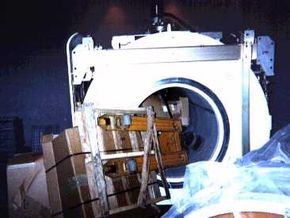Key Takeaways
- MRI machines use incredibly powerful magnets, ranging from 0.5 Tesla to 3.0 Tesla (5,000 to 30,000 gauss), with research magnets reaching up to 60 Tesla.
- Metal objects in the MRI suite can become dangerous projectiles, due to the magnetic force.
- Patients and staff are thoroughly screened for metal objects before entering the scan room to prevent injuries from the magnetic field.
The biggest and most important component in an MRI system is the magnet. The magnet in an MRI system is rated using a unit of measure known as a Tesla. Another unit of measure commonly used with magnets is the gauss (1 Tesla = 10,000 gauss). The magnets in use today in MRI are in the 0.5-Tesla to 3.0-Tesla range, or 5,000 to 30,000 gauss. Extremely powerful magnets -- up to 60 Tesla -- are used in research. Compared with the Earth's 0.5-gauss magnetic field, you can see how incredibly powerful these magnets are.
Because of the power of these magnets, the MRI suite can be a very dangerous place if strict precautions are not observed. Metal objects can become dangerous projectiles if they are taken into the scan room. For example, paperclips, pens, keys, scissors, hemostats, stethoscopes and any other small objects can be pulled out of pockets and off the body without warning, at which point they fly toward the opening of the magnet (where the patient is placed) at very high speeds, posing a threat to everyone in the room. Credit cards, bank cards and anything else with magnetic encoding will be erased by most MRI systems.
Advertisement
The magnetic force exerted on an object increases exponentially as it nears the magnet. Imagine standing 15 feet (4.6 m) away from the magnet with a large pipe wrench in your hand. You might feel a slight pull. Take a couple of steps closer and that pull is much stronger. When you get to within 3 feet (1 meter) of the magnet, the wrench likely is pulled from your grasp. The more mass an object has, the more dangerous it can be -- the force with which it is attracted to the magnet is much stronger. Mop buckets, vacuum cleaners, IV poles, oxygen tanks, patient stretchers, heart monitors and countless other objects have all been pulled into the magnetic fields of MRI machines. Smaller objects can usually be pulled free of the magnet by hand. Large ones may have to be pulled away with a winch, or the magnetic field may even have to be shut down.
Prior to allowing a patient or support staff member into the scan room, he or she is thoroughly screened for metal objects -- and not just external objects. Often, patients have implants inside them that make it very dangerous for them to be in the presence of a strong magnetic field. Metallic fragments in the eye are very dangerous because moving those fragments could cause eye damage or blindness. People with pacemakers cannot be scanned or even go near the scanner because the magnet can cause the pacemaker to malfunction. Aneurysm clips in the brain can be very dangerous as the magnet can move them, causing them to tear the very artery they were placed on to repair.
MRI magnetic fields are incredibly strong. A watch flying off an arm and into the MRI machine is entirely possible.
Advertisement
